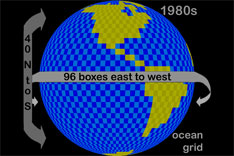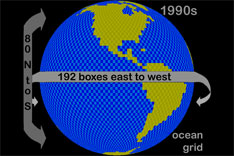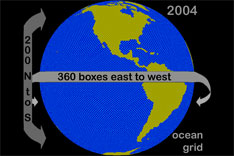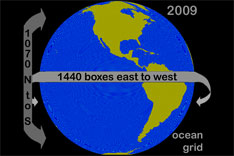Climate Modeling
Climate models are important tools for improving our understanding and predictability of climate behavior on seasonal, annual, decadal, and centennial time scales. Models investigate the degree to which observed climate changes may be due to natural variability, human activity, or a combination of both. Their results and projections provide essential information to better inform decisions of national, regional, and local importance, such as water resource management, agriculture, transportation, and urban planning. The Geophysical Fluid Dynamics Laboratory has been one of the world leaders in climate modeling and simulation for the past 50 years. Beginning in the 1960s, GFDL scientists developed the first coupled ocean-atmosphere general circulation climate model, and have continued to pioneer improvements and advances in a growing modeling community. State-of-the art climate modeling at GFDL requires vast computational resources, including supercomputers with thousands of processors and petabytes of data storage.
What is a Global Climate Model?
A global climate model (GCM) is a complex mathematical representation of the major climate system components (atmosphere, land surface, ocean, and sea ice), and their interactions. Earth’s energy balance between the four components is the key to long-term climate prediction. The main climate system components treated in a climate model are:
- The atmospheric component, which simulates clouds and aerosols, and plays a large role in transport of heat and water around the globe.
- The land surface component, which simulates surface characteristics such as vegetation, snow cover, soil water, rivers, and carbon storing.
- The ocean component, which simulates current movement and mixing, and biogeochemistry, since the ocean is the dominant
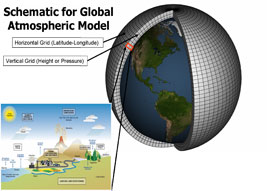 reservoir of heat and carbon in the climate system.
reservoir of heat and carbon in the climate system. - The sea ice component, which modulates solar radiation absorption and air-sea heat and water exchanges.
Climate models divide the globe into a three-dimensional grid of cells representing specific geographic locations and elevations. Each of the components (atmosphere, land surface, ocean, and sea ice) has equations calculated on the global grid for a set of climate variables such as temperature. In addition to model components computing how they are changing over time, the different parts exchange fluxes of heat, water, and momentum. They interact with one another as a coupled system.
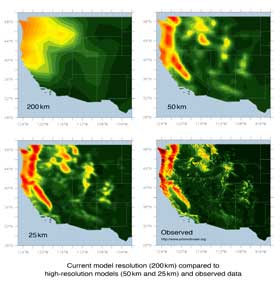 Grid size is dependent upon the power of the computer that is available to solve these equations. Finer resolution implies a larger number of grid cells and requires a bigger and faster computer to perform the simulation. Similarly, if grid spacing is farther apart, there are fewer points that are calculated, but the results are also less detailed. Once the simulated time rate of change is computed (for example, how fast each particular grid cell is warming or cooling) that rate is assumed to hold for some length of time, and the updated values are computed at each grid point according to the previous values and trends. Then, calculations start over again for the next time interval.
Grid size is dependent upon the power of the computer that is available to solve these equations. Finer resolution implies a larger number of grid cells and requires a bigger and faster computer to perform the simulation. Similarly, if grid spacing is farther apart, there are fewer points that are calculated, but the results are also less detailed. Once the simulated time rate of change is computed (for example, how fast each particular grid cell is warming or cooling) that rate is assumed to hold for some length of time, and the updated values are computed at each grid point according to the previous values and trends. Then, calculations start over again for the next time interval.
There are two types of processes within climate models that are used today: simulated and parameterized. Simulated processes are larger than grid-scale and based on bedrock scientific principles (conservation of energy, mass, and momentum). An example of a simulated process is one that represents tropical cyclones and storm activity. Parameterized processes represent more complex processes that are smaller than grid scale (so, cannot be physically represented) using simpler processes. Their formulations are guided by fundamental physical principles, but also make use of observational data. An example of a parameterized process is one that represents cloud and aerosol composition.
What Are Their Uses?
GCMs are critical tools that enable us to improve the understanding and prediction of atmosphere, ocean, and climate behavior. Models allow us to determine the distinct influence of different climate features by providing a way of exploring climate sensitivities with experiments that cannot be performed on the actual earth. Changes can be made to one feature in a climate model, such as warming or cooling ocean surface temperatures, to discern the impact those changes have on the climate. The uses for climate modeling also include diagnosis and prognosis. An example of a diagnostic use is detection and attribution. Detection and attribution require first demonstrating that a detected change is statistically significant, and then attributing this change to unnatural causes such as the role of anthropogenic forcing in 20th century climate change. Prognostic climate modeling predicts future climate, such as global warming trends, using current or historic data (ocean structure, radiative forcing, etc) as a basis. Timescales for projection include seasonal/interannual variability, decadal prediction, and 21st century scenarios.
Why Do We Believe Them?
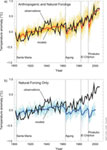 Although there is some level of disagreement among climate models, these models are based on well-founded physical principles either directly for simulated processes or indirectly for parameterized processes. The results of one experiment are extensively checked by a large community of modelers and researchers around the world (for example, as part of the IPCC), which reduces uncertainty. Generally, models produce simulations of current and past large-scale climates that agree with observations. Climate models have also produced an accurate hindcast of 20th century climate change, including increased warming partly due to CO2 emissions. This gives us confidence in using these models to project future climate change.
Although there is some level of disagreement among climate models, these models are based on well-founded physical principles either directly for simulated processes or indirectly for parameterized processes. The results of one experiment are extensively checked by a large community of modelers and researchers around the world (for example, as part of the IPCC), which reduces uncertainty. Generally, models produce simulations of current and past large-scale climates that agree with observations. Climate models have also produced an accurate hindcast of 20th century climate change, including increased warming partly due to CO2 emissions. This gives us confidence in using these models to project future climate change.
What Do They Agree On?
Climate models agree on certain basic aspects of future climate change. For example, they all show rising global temperatures with amplified warming in the Arctic, enhancement of the hydrologic cycle (dry places becoming dryer and wet places becoming wetter), and rising sea level. Many of these factors affect each other and could be drastically altered in an already changing climate. Climate models reduce the uncertainty of climate change impacts, which aids in adaptation. Generally, more confidence is placed in simulations that are at larger scales because of the agreement in global averages and patterns.
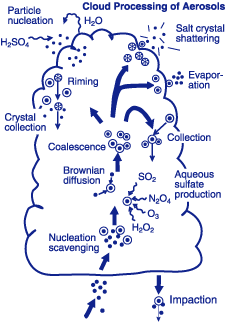 Why Do They Disagree?
Why Do They Disagree?
Climate models can disagree on many results and projections due to natural variability, differences in forcing, and differences in feedbacks. Natural climate variability can be reduced by using an ensemble of simulations with slight changes in each, which produces an average result and reveals the response to forcing. However, forcings vary greatly among climate models. Forcings are the prime movers of climate change, and the main differences among models involve aerosols. The impact of aerosols on earth’s energy balance is uncertain. Therefore, climate feedback to aerosols, such as existence and concentration of water vapor and clouds, differs because of this uncertainty in the parameterized processes.
How Do We Improve Them?
Increasing climate model accuracy involves continually improving its completeness, correctness, and resolution. This includes the addition of new processes that represent components such as land and ocean carbon cycles, interactions between cloud droplets and aerosols, and ice sheets. These components are initially developed and tested offline before they are coupled into the climate model and are allowed to interact with the other components.
Climate modeling is already computationally intensive, but increased computing power would allow for more comprehensive simulations, better represented parameterized processes, and more accurate climate change projections at regional and local levels.



